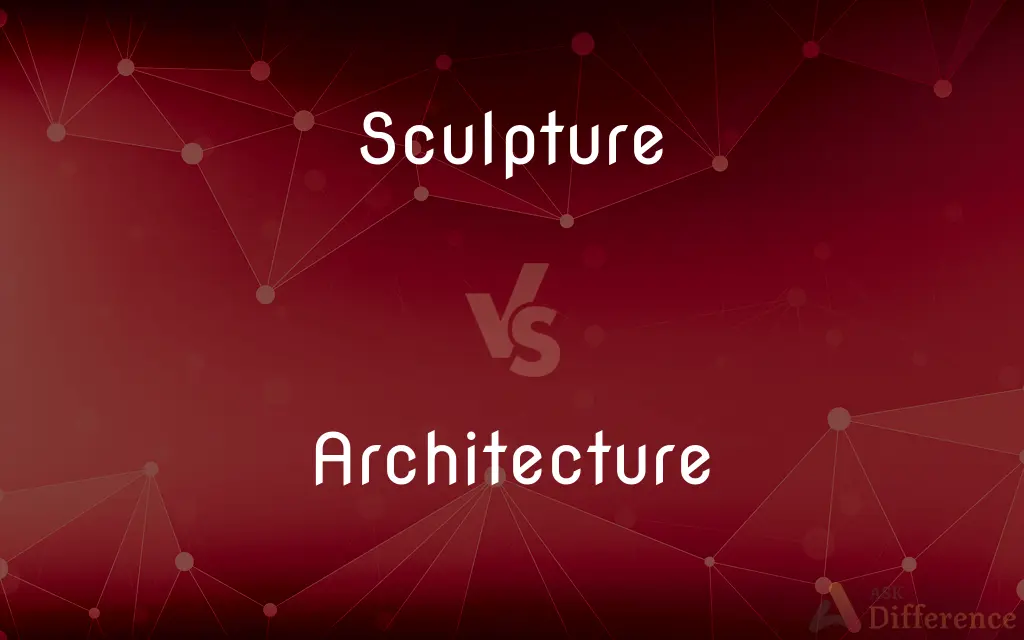Sculpture vs. Architecture — What's the Difference?
By Urooj Arif & Fiza Rafique — Updated on April 17, 2024
Sculpture is a three-dimensional art form focused on aesthetic expression through materials like stone or metal, while architecture involves designing and constructing buildings for functionality and spatial experience.

Difference Between Sculpture and Architecture
Table of Contents
ADVERTISEMENT
Key Differences
Sculpture primarily explores artistic expression, utilizing materials such as clay, metal, and wood to create standalone artworks. In contrast, architecture uses materials like concrete, steel, and glass to construct functional spaces and structures.
Sculptors work with a focus on form, texture, and the interplay of light and shadow to evoke emotional responses. On the other hand, architects must consider not only aesthetic appeal but also structural stability, building codes, and the needs of potential occupants.
A sculpture can be an abstract or representational representation, offering a personal, interpretative experience. Meanwhile, architecture often represents collective values and practicalities, aiming to serve a community or a specific purpose.
The scale of sculptures can vary widely, from small handheld pieces to monumental installations. Conversely, architecture typically operates on a much larger scale, encompassing everything from single rooms to entire cityscapes.
Sculpture is an art form that invites viewers to experience and interpret it from multiple angles and in varying lights. Architecture, while also experienced in three dimensions, interacts with its environment and users more dynamically, shaping and being shaped by its surroundings.
ADVERTISEMENT
Comparison Chart
Definition
Art of creating three-dimensional forms.
Art and science of designing and erecting buildings.
Materials
Uses clay, stone, metals, wood, and plastics.
Utilizes concrete, brick, steel, glass, and wood.
Purpose
Aesthetic expression and interpretation.
Functional spaces for living, working, or recreation.
Scale
Can range from small to monumental.
Generally large-scale, influencing cityscapes.
Viewer Interaction
Viewed at multiple angles; physically static.
Used and experienced; dynamic interaction with users.
Compare with Definitions
Sculpture
The practice of creating sculptures as a profession.
He pursued a career in sculpture after discovering his talent in college.
Architecture
The profession of designing buildings, open areas, communities, and other artificial constructions and environments.
His architecture firm has won several international awards.
Sculpture
The art of making two- or three-dimensional representative or abstract forms, especially by carving stone or wood or by casting metal or plaster.
The park displayed a sculpture carved from a single block of marble.
Architecture
The art or practice of designing and constructing buildings.
She studied architecture, focusing on sustainable design.
Sculpture
An individual piece of such art.
She admired the sculpture of the ancient goddess.
Architecture
The complex or carefully designed structure of something.
The architecture of the new software was designed for speed and efficiency.
Sculpture
The process or art of using modeling material to create figures.
Sculpture classes often begin with clay modeling.
Architecture
A style and method of design and construction of buildings.
The museum was an excellent example of modern architecture.
Sculpture
A work of art that is produced by shaping or combining hard materials.
His latest sculpture uses mixed materials, including iron and glass.
Architecture
The characteristic or style of building design.
The quaint village's architecture draws tourists every year.
Sculpture
Sculpture is the branch of the visual arts that operates in three dimensions. It is one of the plastic arts.
Architecture
Architecture (Latin architectura, from the Greek ἀρχιτέκτων arkhitekton "architect", from ἀρχι- "chief" and τέκτων "creator") is both the process and the product of planning, designing, and constructing buildings or other structures. Architectural works, in the material form of buildings, are often perceived as cultural symbols and as works of art.
Sculpture
The art or practice of shaping figures or designs in the round or in relief, as by chiseling marble, modeling clay, or casting in metal.
Architecture
The art and science of designing and erecting buildings.
Sculpture
A work of art created by sculpture.
Architecture
Buildings and other large structures
The low, brick-and-adobe architecture of the Southwest.
Sculpture
Such works of art considered as a group.
Architecture
A style and method of design and construction
Byzantine architecture.
Sculpture
Ridges, indentations, or other markings, as on a shell, formed by natural processes.
Architecture
Orderly arrangement of parts; structure
The architecture of the federal bureaucracy.
The architecture of a novel.
Sculpture
To sculpt.
Architecture
(Computers) The overall design or structure of a computer system or microprocessor, including the hardware or software required to run it.
Sculpture
To ornament with sculpture
Sculptured the façade of the cathedral.
Architecture
Any of various disciplines concerned with the design or organization of complex systems
Enterprise architecture.
Sculpture
To make sculptures or a sculpture.
Architecture
The art and science of designing and managing the construction of buildings and other structures, particularly if they are well proportioned and decorated.
The architecture throughout NYC is amazing.
Sculpture
(countable) A three dimensional work of art created by shaping malleable objects and letting them harden or by chipping away pieces from a rock (sculpting).
Architecture
The profession of an architect.
Sculpture
Works of art created by sculpting, as a group.
Architecture
Any particular style of building design.
Sculpture
(zoology) The three-dimensional ornamentation on the outer surface of a shell.
Architecture
Construction, in a more general sense; frame or structure; workmanship.
Sculpture
(archaic) A printed picture, such as an engraving.
Architecture
A unifying structure.
Sculpture
To fashion something into a three-dimensional figure.
Architecture
(computing) A family of CPUs sharing a common instruction set and having partial or full compatibility with software built on each other.
Sculpture
To represent something in sculpture.
Architecture
(computing) A specific model of a microchip or CPU.
The Intel architectures have more software written for them.
Sculpture
To change the shape of a land feature by erosion etc.
Architecture
The structure and design of a system or product.
The architecture of the company's billing system is designed to support its business goals.
Sculpture
The art of carving, cutting, or hewing wood, stone, metal, etc., into statues, ornaments, etc., or into figures, as of men, or other things; hence, the art of producing figures and groups, whether in plastic or hard materials.
Architecture
The art or science of building; especially, the art of building houses, churches, bridges, and other structures, for the purposes of civil life; - often called civil architecture.
Many other architectures besides Gothic.
Sculpture
Carved work modeled of, or cut upon, wood, stone, metal, etc.
There, too, in living sculpture, might be seenThe mad affection of the Cretan queen.
Architecture
Construction, in a more general sense; frame or structure; workmanship.
The architecture of grasses, plants, and trees.
The formation of the first earth being a piece of divine architecture.
Sculpture
To form with the chisel on, in, or from, wood, stone, or metal; to carve; to engrave.
Architecture
An architectural product or work
Sculpture
A three-dimensional work of plastic art
Architecture
The discipline dealing with the principles of design and construction and ornamentation of fine buildings;
Architecture and eloquence are mixed arts whose end is sometimes beauty and sometimes use
Sculpture
Creating figures or designs in three dimensions
Architecture
The profession of designing buildings and environments with consideration for their esthetic effect
Sculpture
Create by shaping stone or wood or any other hard material;
Sculpt a swan out of a block of ice
Architecture
(computer science) the structure and organization of a computer's hardware or system software;
The architecture of a computer's system software
Sculpture
Shape (a material like stone or wood) by whittling away at it;
She is sculpting the block of marble into an image of her husband
Common Curiosities
What is architecture?
Architecture is the art and science of designing buildings and other physical structures to be functional and aesthetically pleasing.
Can architecture be considered a form of sculpture?
While architecture and sculpture share artistic elements, architecture must also adhere to practical and functional requirements not typically present in sculpture.
Can both sculpture and architecture serve public purposes?
Yes, both can serve public purposes; sculptures can enhance public spaces, and buildings can provide necessary infrastructure like schools and hospitals.
How do scale and size compare in sculpture and architecture?
Sculpture can range from very small to very large scales, while architecture generally operates at a larger scale, influencing not just individual experiences but also urban planning.
How does the viewer's interaction with sculpture differ from architecture?
Viewers typically interact with sculpture by viewing and interpreting its forms and meanings, while architecture is experienced by inhabiting and utilizing the space.
What is monumental sculpture, and how does it compare to architecture?
Monumental sculpture is a large-scale sculpture intended for public viewing and interaction, similar to public buildings in architecture which are designed to be accessible and functional for the public.
How does the purpose of sculpture differ from architecture?
The purpose of sculpture is mainly artistic expression and visual interaction, whereas architecture focuses on creating functional spaces for human use.
What is the role of an architect compared to a sculptor?
An architect designs buildings and spaces that are functional and safe for everyday use, while a sculptor focuses on the artistic creation without the constraints of functionality.
What is sculpture?
Sculpture is the art of creating three-dimensional works designed mainly for aesthetic purposes, often using materials like stone, metal, or wood.
What are common materials used in sculpture compared to architecture?
Sculpture often uses materials like bronze, stone, and clay, while architecture uses materials such as steel, concrete, and glass for structural purposes.
How do historical contexts influence sculpture and architecture?
Both fields are deeply influenced by their historical contexts, reflecting cultural values, technological advancements, and artistic trends of their times.
Are there crossover professionals who work both in sculpture and architecture?
Yes, some professionals apply their artistic talents to both fields, particularly in areas like landscape architecture or the design of artistic installations within buildings.
What educational paths do sculptors and architects typically take?
Sculptors may study fine arts or sculpture specifically, while architects usually require a degree in architecture and licensure.
How do environmental considerations affect sculpture and architecture?
Environmental factors influence the durability and placement of sculptures and are crucial in architecture for building sustainability and resilience.
Share Your Discovery

Previous Comparison
Follow vs. Lead
Next Comparison
Convention vs. ProtocolAuthor Spotlight
Written by
Urooj ArifUrooj is a skilled content writer at Ask Difference, known for her exceptional ability to simplify complex topics into engaging and informative content. With a passion for research and a flair for clear, concise writing, she consistently delivers articles that resonate with our diverse audience.
Co-written by
Fiza RafiqueFiza Rafique is a skilled content writer at AskDifference.com, where she meticulously refines and enhances written pieces. Drawing from her vast editorial expertise, Fiza ensures clarity, accuracy, and precision in every article. Passionate about language, she continually seeks to elevate the quality of content for readers worldwide.














































